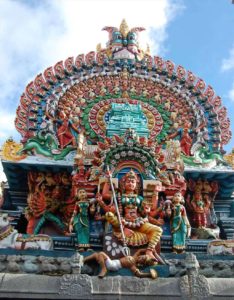
Kali statue at the Thillai Kali Temple in Chidambaram, India.
Kali is a Hindu goddess, whose name is derived from the Sanskrit word ‘Kal’, which means time. She like all other female deities, is believed to be an incarnation of Parvati. Parvati was both the original wife of Shiva and the ‘Divine Mother’ in Hinduism. While representing the fearful aspects of a motherly figure, Kali is also believed to hold connections to death and warfare. She’s predominantly worshipped in Eastern and Southern India; specifically, in Kashmir, Bengal and areas of Kerala. While she does represent the fearful aspects of a motherly figure, some of the elements of her depiction do hint that she can also be viewed in a much more peaceful way.
She’s shown as being either black or blue, and having snakes all over her body, head and around her neck. Multiple hands are a characteristic of Hindu deities, with some like Durga having up to eighteen.
Kali has four hands, each summarising a different aspect of her personality. In one of these she holds a sword dripping with demon blood, and in another she holds a severed demon head. One of her hands is raised in a peaceful gesture, whilst the other is grasping for further power. These final two hands are believed to bestow blessings on those who worship her, as well as showing that she was not to be feared. Occasionally, Kali will also be shown with three eyes. As a goddess of time, these eyes are believed to represent the past, present and future.
She is shown wearing two severed human heads as her earrings, demon skulls as a necklace and a girdle made of human hands. However, her white teeth hint to her inner purity, emphasising her depiction as a goddess with pure and motherly aspects. At her feet usually lies the body of her husband Shiva whom she was told as trampling in Hindu mythology. Despite her fearsome appearance, she is thought to be beautiful to both mortals and other deities.
Kali originally appears to have been an early warrior goddess, who was later absorbed into the Hindu Pantheon as a creation deity. This appears to have occurred as a result of the Devi Mahatmya which dates to the 5th or 6th century CE. While there are many different stories of her creation, the most popular is in relation to the warrior goddess Durga. This particular story tells of the warrior deity riding into a battle with the buffalo demon, Mahishasura. During this battle, she became so enraged that her anger burst from her forehead in the form of Kali. As she was born through anger, she went on a killing spree and destroyed all of the demons that she came across, stringing their heads onto her necklace as she went. In order to stop her before she attacked mankind, the creation deity Shiva threw himself under her feet which shocked her out of her blood lust. In her astonishment, she stuck out her tongue. It is as a result of this, that Kali is predominantly depicted with Shiva beneath her feet and her large tongue protruding from her mouth.
In another myth relating to Kali and Shiva, the couple are believed to have danced together in a competition to settle an argument. Kali is already believed to dance an eternal dance, which causes the cycle of the creation, life and death of everything in the universe. However, she and Shiva became more competitive as time went on until it appeared that the whole world would be destroyed. The competition was eventually lost by Kali, as Shiva performed a masculine dance move that due to her modesty, she was unable to replicate therefore making him the winner.
Hinduism believes that the world exists throughout four separate ages or ‘Yugas’. These are the Satya Yuga, Treta Yuga, Dwapar Yuga and Kali Yuga. We currently live in the final period, which began in 3102 BCE and will last for a total of 432,000 years. The Kali Yuga is mentioned in both The Ramayana and the Mahabharata and is characterised as the age where war, crime and famine are commonplace. It is believed that at the end of this Yuga, Shiva will destroy the current universe and the four ages will be reborn. Interestingly, the time scale of this Hindu prophecy also matches an ancient Mayan prophecy of the rebirth of the universe. This is not the only similarity between the two, as each believes in the existence of a ‘trinity’ which makes up the universe. To read more about these, please find more information here.
-Devon Allen
Junior Girl
Girl Museum Inc.
